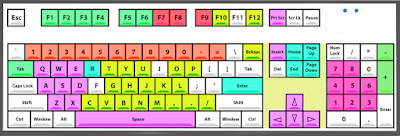Function keys of computer keyboard
Finding Your way Around a Keyboard
Most personal computer keyboards have three main parts;
- Function keys
- The main keyboard in the center
- Andnumeric keys to the right.
Extende keyboard, cush as the keyboard shown here, habe additional keys between the main keyboard and the numeric keys and status light in the upper-righ corner.
A keyboard, which uusually is similar to a typewriter, may be part of a personal computer or part of a terminal that is connected to a computer somewhere else.
 |
| Keyboard |
Function Keys of Computer Keyboard
The function keys (highlighted in tan on the diagram) are an easy way to give certain commands to the computer. What each function key does is defined by the particular software you are using.
Main Keyboard
The main keyboard includes the familiar keys found on a typewriter keyboard (dark blue), as well as some special command keys have different uses that depend on the software being used. Some of the most common user are listed here.
Numeric Keys
The numeric keys (purple) serve one of two purposes, depending on the status of the Num Lock key. When the computer is in the Num Lock mode, these keys can be used to enter numeric data and mathematical symbols (/for"divined by, "*for"multiplied by"-,and+). In the Num Lock mode, the status light under "Num Lock" lights up. Whwn the computer is not in the Num Lock mode, the numeric keys can be used to move the cursor and perform other functions. For example ;
Additional Keys
Extended keyboards include additional keys (green) that duplicate the cursor movement functions of the numeric keys. User who enter a lot of numeric data can leave their computers in the Num ock mode and use these additional keys to control the cursor. The arrow keys, to the left of the numeric keys, move the cursor position, just as the numeric keys 2,4,6, and 8 do when they are not in the Num Lock mode.
Just above the arrow keys are six keys-insert, Delete, Home, End, Pageup, and PageDown,-which duplicate functions of the numeric keys 0, decimal point (Del), 7,1,9, and 3.
At the top of the keyboard, to the right of the function keys, are keys that perform additional tasks. For example ;





















0 Response to "Function keys of computer keyboard"
Post a Comment